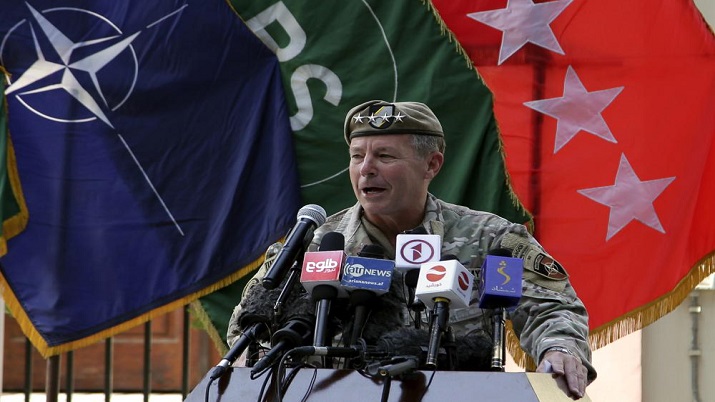
The top US commander in Afghanistan, US Army General Scott Miller, speaks at a ceremony at Resolute Support Headquarters in Kabul, Afghanistan, where he left his command.
The top US commander in Afghanistan resigned Monday at a ceremony in the capital, Kabul, as the United States moved closer to ending its 20-year war. The move came as Taliban insurgents continued to gain territory across the country.
Another four-star general will assume authority from his US-based position to conduct possible air strikes in defense of Afghan government forces, at least until the US withdrawal ends on August 31.
General Scott Miller served as America’s top commander in Afghanistan since 2018. He led Marine General Frank McKenzie, the head of US Central Command, in what is known as America’s “forever war” in its heyday. McKenzie will operate from Central Command Headquarters in Tampa, Florida.
During the handover, McKenzie credits Miller with getting American troops home safely and taking out millions of tons of equipment. This has rankled some Afghan security officials who complained that discardable equipment for Afghanistan’s security forces had been taken away.
Afghanistan’s National Security Adviser Hamdulla Mohib, who participated in the handover, said the US and NATO withdrawal has left a void that has resulted in Afghanistan’s national security forces being stranded on the battlefield without supplies, sometimes food. and run out of ammunition.
In remarks after the ceremony, Mohib said the biggest impact of the withdrawal is the lack of aircraft to re-supply troops. Currently, the government is regrouping to re-capture strategic areas and defend its cities against Taliban advances.
The handover took place at the heavily determined support headquarters in the center of Kabul at a time of rapid territorial gains by Taliban insurgents across Afghanistan.
Abdullah Abdullah, the head of Afghanistan’s National Reconciliation Council, was present. He rejected suggestions that the Taliban could make a military takeover.
“I am certainly concerned, when the Taliban are pushing for a military solution, it is a cause for concern … but they cannot militarily impose their will on the nation,” he said.
Last month, Abdullah traveled with President Ashraf Ghani to Washington, where President Joe Biden assured leaders that the US would continue its humanitarian support. While he said there would no longer be military boots on the ground, the US is not giving up on the country’s security needs.
At a flag-hoisting ceremony, Miller remembered American and NATO soldiers killed in nearly 20 years of war, as well as the thousands of Afghans who lost their lives.
He warned that the continuing violence across Afghanistan was making a political solution difficult. The outgoing commander said he told Taliban officials, “It is important that the military side set the conditions for a peaceful and political solution in Afghanistan. … But we know that violence will make it very difficult to reach a political settlement.”
Afghanistan’s National Defense and Security Forces, mostly funded by the United States and NATO, have met with resistance in some parts of the country, but heavy Afghan government troops have abandoned fighting.
In recent weeks, the Taliban have seized several strategic districts, particularly along the borders with Iran, Uzbekistan and Tajikistan.
The Taliban control more than a third of Afghanistan’s 421 districts and district centres. A Taliban claim that they control 85% of the districts is widely considered exaggerated.
After Miller leaves, a two-star admiral based at the US embassy in Kabul will oversee the role of the US military in securing a US diplomatic presence in Kabul, including the defense of Kabul airport.
Miller’s departure does not reduce the limited range of US military missions in Afghanistan. McKenzie would under certain circumstances assume the authority held by Miller to conduct air strikes in defense of Afghan government forces. The conditions under which such attacks could be exercised are not clear, nor is it known how long Mackenzie will hold that right.
The agreement the US signed with the Taliban in February 2020 included a promise from the insurgent movement not to attack US and NATO troops, a commitment they appear to have largely kept.
While Washington is not saying how many troops are in Afghanistan, a CentCom statement more than a week ago said the withdrawal was 90 percent complete.
The US is also committed to spending $4.4 billion annually to fund Afghanistan’s security forces by 2024.
Read also | Taliban claim to have captured 85 percent of Afghanistan
Read also | US military mission in Afghanistan will end on August 31: Biden
.